Jamie Bourgeois is an Atlanta-based fiber artist, painter, and gallery director at Spalding Nix Fine Art, who creates ‘slow’ works that remind and raise awareness of the importance of protecting our native ecosystems. “Petrochemical PLANTS” is a series of mixed-media paintings that explore the pervasive and insidious nature of plastics and petrochemicals and embody a deep love for the natural world. Textured, layered scenes of lush landscapes and dense native foliage, painted with earth pigment oil paints on wood panels, are adorned, surrounded, and smothered in assembled beads of discarded plastic.
Raised in rural Southeast Louisiana along the Mississippi River, towering and winding structures of steel and PVC, bright fiery flairs that light up the night sky, dense morning fog, and intense pink and orange particulate sunsets were commonplace. As the area is drenched in petrochemical plants, it holds the nicknames ‘Cancer Alley,’ the ‘Chemical Corridor,’ a ‘sacrificial zone.’ As a multi-disciplinary artist, Jamie’s works examine the impacts of human interactions within native ecosystems and remind us of the importance of protecting that with which we are interconnected.
PLASTICS in the Environment:
Plastic pollution is cumulative in our bodies and in the environment. It is not biodegradable or beneficially cyclical and has a long lifespan of quietly off-gassing and leeching toxic chemicals into its surroundings. Ubiquitous, shape-shifting, and inescapable, plastic constitutes the majority of our packaging, clothing, electronics, toys, appliances, furniture, and a multitude of everyday objects. It has been found in nearly every ecosystem across the globe, even in places scarcely or not at all inhabited by humans; from the Arctic Circle to the deepest ocean trench. It has been found in raindrops, in the bellies of birds, and inside human organs, tissues, and blood. Produced on an escalating scale, plastics are made to be cheaply consumed, utilized temporarily, thrown away, and purchased repeatedly. Made from fossil fuels, the refining process produces hazardous waste in the form of air, land, and water pollution, with petrochemical plants predominantly located in low-income communities and communities of color. Several of the chemicals found in plastics and plastics production are known carcinogens and endocrine disruptors causing developmental, neurological, reproductive, and immune disorders in humans and wildlife.
“All life on earth depends on regenerative cycles—an infinite number of beautifully wonky revolutions and webs that continue in perpetuity within us and all around us,” says Jamie. “Plastic and its compositions of chemicals disrupt, obstruct, and break those cycles. These paintings act as windows, as mirrors, as seeds–which systems do we want to protect and (how) do we want our future to grow?”
"Manufactured Demand," discarded plastic on naturally dyed cotton canvas on panel, 14 by 11 inches (excluding installation)

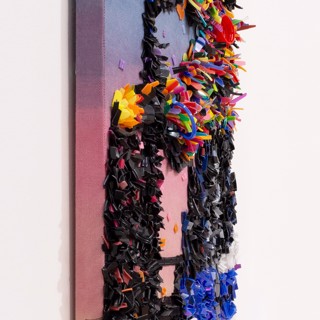
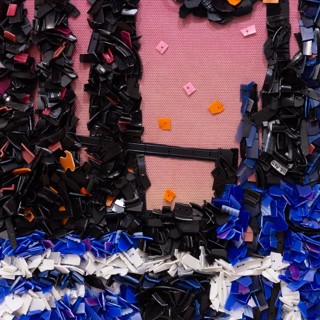
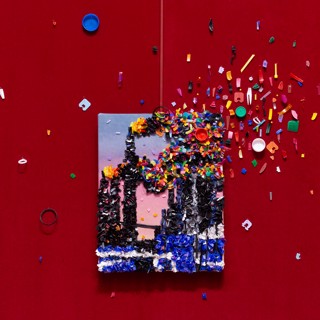

"(Petrochemical PLANTS) In the Forest," earth pigment oil paint on panel, discarded plastic, naturally dyed cotton canvas, 13 by 11 inches
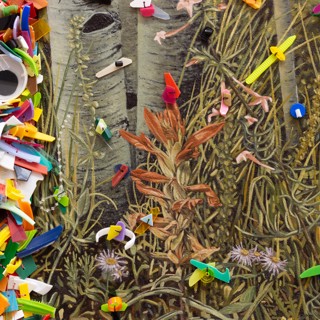

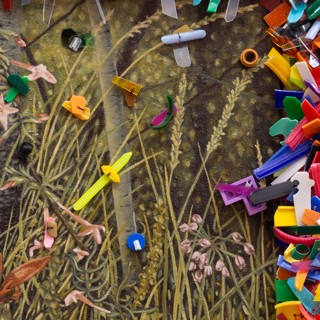
"(Disruptive in Nature) Polyethylene Terephthalate (PET)," earth pigment oil paint & synthetic oil paint on panel, 6 by 6 inches, 7.5 by 7.5 inches framed
"(Petrochemical PLANTS) In the Desert," earth pigment oil paint on panel, discarded plastic, naturally dyed cotton canvas, 13 by 11 inches
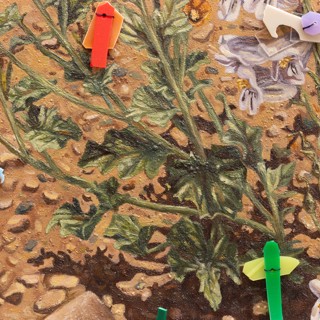
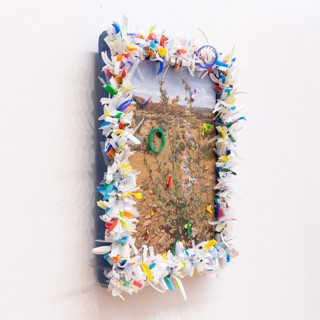
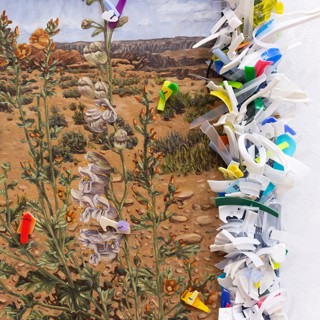
"(Disruptive in Nature) Polypropylene (PP)," earth pigment oil paint & synthetic oil paint on panel, 6 by 6 inches, 7.5 by 7.5 inches framed
"Petrochemical PLANTS) In the Swamp, " earth pigment oil paint on panel, discarded plastic, naturally dyed cotton canvas, 13 by 11 inches
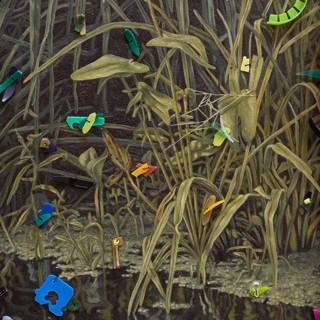
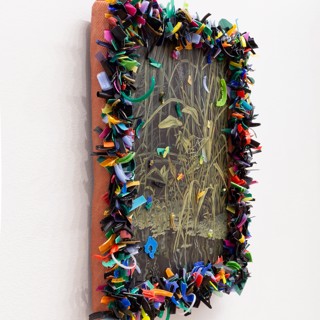
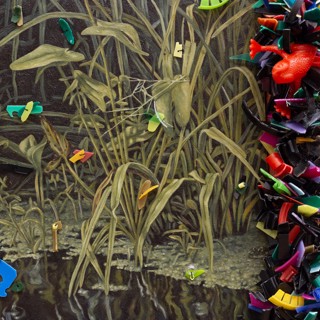
"(Disruptive in Nature) Low-Density Polyethylene (LDPE)," earth pigment oil paint & synthetic oil paint on panel, 6 by 6 inches, 7.5 by 7.5 inches framed
"(Petrochemical PLANTS) In the Garden," earth pigment oil paint on panel, discarded plastic, naturally dyed cotton canvas, 13 by 11 inches

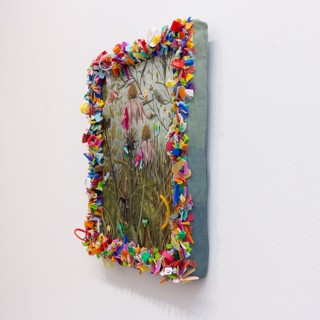
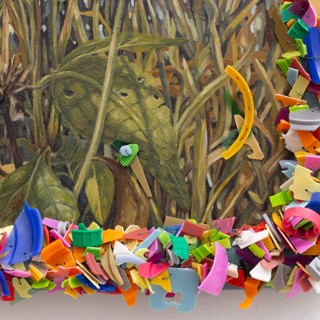
"(Possibility Over Peril) Hollyhock Mallow," earth pigment oil paint & discarded plastic on panel, 8 by 8 inches
"(Possibility Over Peril) Primrose-willow" earth pigment oil paint & discarded plastic on panel, 8 by 8 inches
"(Possibility Over Peril) Eastern Red Columbine," earth pigment oil paint & discarded plastic on panel, 8 by 8 inches
I don’t have a list of easy or absolute solutions to offer. Recycling is imperfect and alternative products are often expensive, however, we as consumers should still be as discerning and strategic as possible. Ultimately, the burden does not fall on us as individuals. What we have is a systemic issue with far too much corporate money in politics. Solutions, alternatives, and better more equitable ways to move forward already exist (see Reading List), but are often slowed or blocked by the maintaining of the status quo. Innovation and production that is geared toward safety, circularity, and sustainability, rather than profits, need to be championed and funded. Industries need to be adequately regulated, monitored, and held accountable by independent, local, state, and the federal government. Reparations to suffering communities, not kickbacks to politicians, need to be paid by the industry. It is past time that we move towards a more circular economy, rather than an extractive one.
Reading List:
Petrochemical America by Kate Orff and Richard Misrach
The Shock Doctrine: The Rise of Disaster Capitalism by Naomi Klein
Silent Spring by Rachel Carson
Cradle to Cradle: Remaking the Way We Make Things by Michael Braungart and William McDonough
What If We Get It Right by Ayana Elizabeth Johnson
All Eyes On:
Rise St. James’s fight to Stop Formosa Plastics
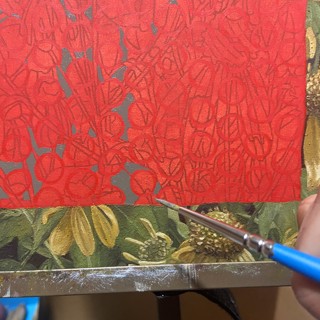
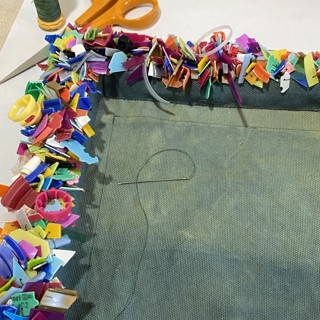
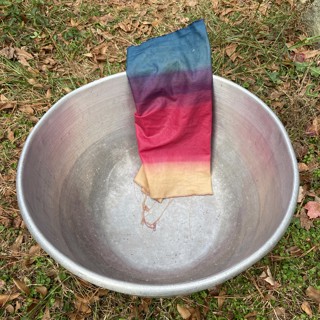
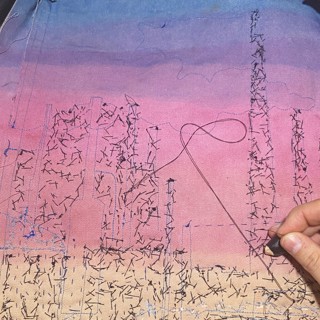
Jamie Bourgeois received her BFA in Fibers from SCAD, Savannah in 2012. She also attended the New Orleans Center for Creative Arts (2008) and was a Corps Member of AmeriCorps NCCC (2013). Within her studio practice, she maintains a perennial study of natural dyes. She has led and assisted with workshops on natural dyes at Georgia State University (2021), The State Botanical Garden of Georgia (2020), Penland School of Craft (2018, assist), and the Textile Society of America Conference (2016, assist). Her work has been included in various group exhibitions in Georgia and Louisiana and in 2020 her work was juried into the exhibition for the Natural Dyes in North America Conference, hosted by The Centre for Fashion Diversity and Social Change at Toronto Metropolitan University and the Royal Ontario Museum in Toronto, Canada. Her work was recently published in The Markup and The Bitter Southerner and featured on WABE’s City Lights–Speaking of Art, the Museum of Design Atlanta’s Design Re: Climate Change podcast, and Botanical Colors’ Feedback Friday.
AVAILABLE WORKS
